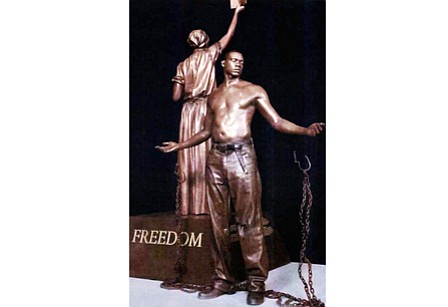Commission selects 10 for Emancipation Proclamation and Freedom Monument on Brown’s Island
Jeremy M. Lazarus | 10/12/2017, 9:27 p.m.
Two leaders of slave rebellions and a Union spy will be among the 10 people who will be featured on the planned Emancipation Proclamation and Freedom Monument to go up on Brown’s Island in Downtown.
That’s the decision of the General Assembly’s Martin Luther King Jr. Memorial Commission, which is spearheading the drive to create the new monument in 2019 to mark the 400th anniversary of the arrival of the first Africans in Virginia.
The commission, led by Richmond state Sen. Jennifer L. McClellan, started with the names of nearly100 people nominated to appear on the statue. The commission made the final selection two weeks ago.
The honorees, whose images and brief biographies are to adorn the monument, are to include five people who contributed to the freedom movement prior to the 1865 emancipation of slaves and five who have contributed since that time.
The first five are:
• Gabriel of Henrico County, the leader of a large, but ultimately aborted slave rebellion in Richmond in 1800;
• Nat Turner of Southampton County, leader of the largest, though ultimately unsuccessful slave revolt in 1831 in Southampton County;
• Mary Elizabeth Bowser of Richmond, the Union spy working in the Confederate White House who provided key information to the military;
• Dred Scott of Southampton County, whose freedom lawsuit led to the infamous U.S. Supreme Court decision in 1857 denying the citizenship rights of African-Americans. The decision helped bring on the Civil War that led to emancipation; and
• William Harvey Carney of Norfolk, who escaped from slavery to fight for the Union in the famed 54th Massachusetts regiment and became the first African-American to receive the Medal of Honor for heroics in the Battle of Fort Wagner, S.C.
The five post-1865 honorees are:
• Rosa Dixon Bowser of Richmond, educator and women’s activist who founded or co-founded local, state and national organizations for African-American teachers and women;
• John Mercer Langston of Louisa, an attorney who represented Virginia in Congress, served as the first president of Virginia State University and earlier as the first dean of Howard University’s law school, which he helped create;
• John Mitchell Jr. of Richmond, a banker, city alderman and fiery editor of the Richmond Planet who fought lynching, segregation and the Ku Klux Klan and was the first African-American candidate for Virginia governor;
• Lucy F. Simms of Harrisonburg, a pioneering educator who taught three generations of children in her hometown; and
• The Rev. Wyatt Tee Walker, who led the anti-segregation movement in Petersburg as pastor of Gillfield Baptist Church, became a co-founder of the Southern Christian Leadership Conference with Dr. Martin Luther King Jr. and served as Dr. King’s chief of staff and SCLC executive director for four years.
The images of the individuals are to be topped by a 12-foot bronze statue representing newly freed slaves. Sculptor Thomas Jay Warren of Oregon has been commissioned to create the monument, which is projected to cost about $800,000.
The commission has said it has secured $500,000 in state funds and would seek private donations for the other $300,000.







